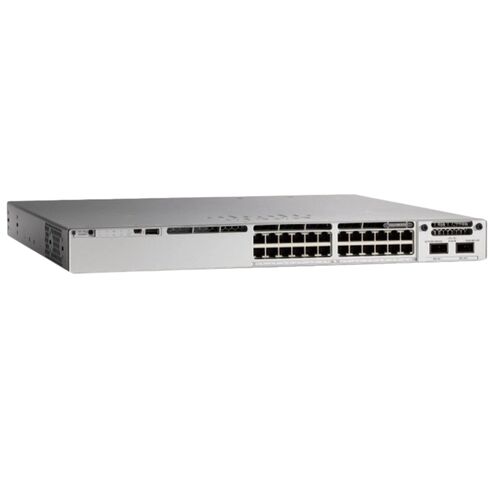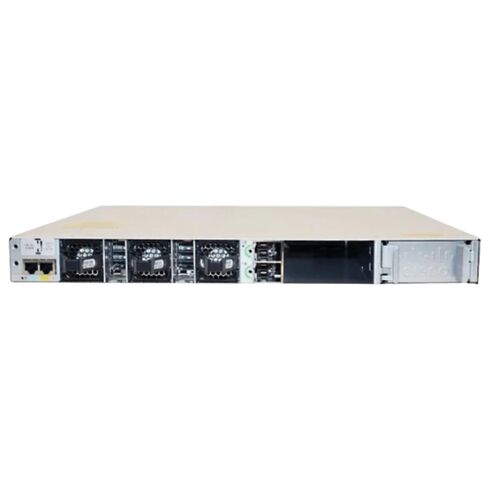C9300-24S-E Cisco Catalyst 9300 Switch Network Essentials 24 Gigabit Fiber
- — Free Ground Shipping
- — Min. 6-month Replacement Warranty
- — Genuine/Authentic Products
- — Easy Return and Exchange
- — Different Payment Methods
- — Best Price
- — We Guarantee Price Matching
- — Tax-Exempt Facilities
- — 24/7 Live Chat, Phone Support
- — Visa, MasterCard, Discover, and Amex
- — JCB, Diners Club, UnionPay
- — PayPal, ACH/Bank Transfer (11% Off)
- — Apple Pay, Amazon Pay, Google Pay
- — Buy Now, Pay Later - Affirm, Afterpay
- — GOV/EDU/Institutions PO's Accepted
- — Invoices
- — Deliver Anywhere
- — Express Delivery in the USA and Worldwide
- — Ship to -APO -FPO
- — For USA - Free Ground Shipping
- — Worldwide - from $30
Same product also available in:
| SKU/MPN | Warranty | Price | Condition | You save |
|---|---|---|---|---|
| C9300-24S-E | 1 Year Warranty | $5,035.00 | Excellent Refurbished | You save: $1,762.25 (26%) |
| C9300-24S-E | 1 Year Warranty | $6,945.00 | Factory-Sealed New in Original Box (FSB) | You save: $2,160.75 (24%) |
High-Performance Switch Overview
Product Type
- Network Switch - 24 Ports
- Layer 3 Functionality
- Managed & Stackable
Form Factor
- 1U Rack-Mountable Enclosure
Connectivity Options
- Gigabit Ethernet Subtype
- 24 x Gigabit SFP Ports
Performance Metrics
Switching Capacity
- 128 Gbps
Stacking Bandwidth
- 480 Gbps
Forwarding Rate
- 154.76 Million Packets Per Second (Mpps)
Routing Protocols Supported
- OSPF
- IS-IS
- RIP-1
- RIP-2
- IGMP
- VRRP
- PIM-SM
- OSPFv3
- PIM-SSM
- Policy-Based Routing (PBR)
- RIPng
Management Features
- SNMP Versions: 1, 2c, 3
- RMON Versions: 1, 2
- CLI (Command Line Interface)
- NETCONF
- RESTCONF
Power Specifications
- AC Input: 120/230 V (50 - 60 Hz)
- Power Redundancy: Available
Physical Dimensions
- Width: 17.5 inches
- Depth: 19.2 inches
- Height: 1.7 inches
Weight
- 16.84 lbs
System Requirements
- Cisco IOS Universal
NetworkType: Optical Fiber
Benefits of Optical Fiber
Optical fiber technology has revolutionized the way data is transmitted and has become an integral part of modern networking systems. With the Cisco C9300-24S-E Switch, you can take advantage of its optical fiber capability, offering numerous benefits for your network infrastructure.
High-Speed Data Transmission
One of the major advantages of using optical fiber is its ability to transmit data at incredibly high speeds. Unlike traditional copper cables, which have limitations in terms of bandwidth and distance, optical fibers offer virtually unlimited bandwidth and can transmit data over long distances without any loss in signal quality. This makes them ideal for high-demand applications such as video streaming, cloud computing, and data-intensive tasks that require fast and reliable connectivity.
Greater Bandwidth Capacity
Optical fiber cables have a much higher bandwidth capacity compared to copper cables. This means that they can handle a significantly larger volume of data traffic simultaneously. As businesses increasingly rely on bandwidth-intensive applications and services, having a network infrastructure that can accommodate this demand is crucial. With optical fiber, you can ensure that your network can handle the ever-increasing data requirements of your organization, providing a seamless user experience and improving overall productivity.
Secure and Immune to Interference
Another important advantage of optical fiber is its immunity to electromagnetic interference (EMI) and radio frequency interference (RFI). Copper cables are susceptible to these interferences, which can degrade the quality of the transmitted signal. Optical fibers, on the other hand, are made of glass or plastic, which are non-conductive materials. This makes them immune to EMI and RFI, providing a secure and reliable transmission medium for your sensitive data.
Longer Distances without Signal Degradation
Optical fibers have the ability to transmit data over much longer distances without any significant signal degradation. This is due to the low attenuation (signal loss) characteristics of the optical fiber material. Copper cables, on the other hand, experience signal loss over longer distances, requiring signal boosters or repeaters to maintain signal integrity. By utilizing optical fiber, you can extend your network connectivity to remote locations without compromising on the quality of the connection.
Importance of Optical Fiber for Users
Optical fiber technology plays a crucial role in modern network infrastructures and is vital for organizations of all sizes. Whether you are a small business or a large enterprise, here are some key reasons why optical fiber is important for users:
Future-Proofing Your Network
Investing in optical fiber infrastructure ensures that your network is future-proofed and can handle the evolving demands of technology. As data requirements continue to grow exponentially, having a reliable and high-speed network becomes essential. By adopting optical fiber technology, you can ensure that your network infrastructure is capable of supporting future advancements and technologies without the need for costly upgrades.
Improved Data Security and Privacy
Optical fiber offers enhanced data security and privacy compared to traditional copper cables. The transmission of data over optical fibers is much more difficult to intercept and tap into, making it an ideal choice for organizations that deal with sensitive information. Additionally, optical fibers do not radiate electromagnetic signals, reducing the risk of data leakage and unauthorized access.
Reduced Maintenance and Downtime
Optical fiber cables are known for their durability and resilience. They are less prone to damage from environmental factors such as moisture, heat, or electromagnetic interference. This means that your network will experience fewer disruptions and require less maintenance compared to networks relying on copper cables. With optical fiber, you can minimize downtime and ensure consistent connectivity for your business operations.
Scalability and Flexibility
Optical fiber networks are highly scalable, allowing you to easily expand your network as your business grows. With copper cables, adding new connections or increasing bandwidth often requires significant infrastructure changes. However, with optical fiber, you can simply add more fiber strands to accommodate additional users and higher data volumes. This scalability and flexibility make optical fiber an ideal choice for businesses that need to adapt quickly to changing demands.
In conclusion, the Cisco C9300-24S-E Switch's support for optical fiber technology provides numerous benefits for users. From high-speed data transmission and greater bandwidth capacity to enhanced security and flexibility, optical fiber is a critical component of modern network infrastructures. By leveraging the advantages of optical fiber, organizations can future-proof their networks, improve data security, reduce maintenance and downtime, and ensure seamless connectivity for their business operations.











